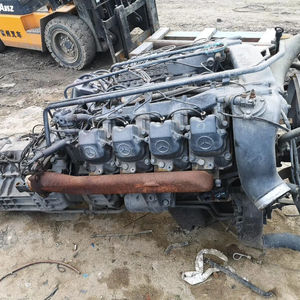Opel Corsa Engine: Top Tips for Upkeep and Care
Reliable and Powerful Small Vehicle Electric Motor Performance Analysis
Assessing the efficiency of tiny auto electric motors is a nuanced task that needs an eager eye for information and a deep understanding of automobile design principles. By examining key metrics such as horse power and torque, as well as reviewing gas effectiveness, we can discover insights right into how little vehicle engines can be maximized for peak efficiency.

Small Automobile Electric Motor Efficiency Metrics
In analyzing the performance of small car motors, vital metrics such as velocity, gas performance, and power output play a critical function in identifying their general effectiveness and viability for different driving problems. Velocity, measured in seconds from 0 to 60 miles per hour, suggests just how rapidly a little vehicle can reach greater rates, which is crucial for merging onto highways or surpassing various other automobiles. Gas efficiency, normally measured in miles per gallon (MPG), shows just how far a little automobile can take a trip on a gallon of gas, influencing running prices and environmental sustainability. Power result, shared in horse power (HP) or kilowatts (kW), symbolizes the engine's ability to produce the needed force to drive the vehicle, influencing its efficiency in various road conditions. By reviewing these performance metrics thoroughly, suppliers, motorists, and vehicle fanatics can make informed decisions regarding the choice and optimization of small vehicle motors to satisfy their particular requirements and preferences.

Horse Power and Torque Evaluation
With an essential role in comprehending tiny auto motor horse power, performance and torque evaluation provides insight into the engine's power delivery attributes. Horse power is a measurement of the engine's capacity to do function over time, standing for the price at which job is done. In the context of little auto electric motors, horse power is essential for identifying velocity, leading rate, and overall efficiency. Torque, on the various other hand, determines the engine's rotational force, indicating its capacity to get rid of resistance. Little auto engines with greater torque values normally really feel more receptive and provide far better acceleration, making them perfect for city driving and overtaking maneuvers. When assessing horsepower and torque in tiny automobile motors, it is important to take into consideration just how these metrics connect to deliver a efficient and well balanced driving experience. By understanding the relationship between horsepower and torque, automotive engineers can maximize engine performance to meet the details needs of tiny car applications.
Gas Efficiency Assessment
The evaluation of gas performance in small vehicle motors plays a critical role in establishing their financial and ecological influence. In little vehicle electric motors, where small size often associates with better gas economic climate, numerous elements influence effectiveness.
To assess fuel performance, metrics such as miles per gallon (MPG) are frequently used. This dimension indicates the distance a lorry can travel per unit of gas. Small automobile electric motors that achieve greater MPG ratings are thought about more fuel-efficient, causing price savings for drivers and minimized emissions that profit the environment. Producers continuously aim to enhance gas performance through innovations in engine innovation, light-weight products, and aerodynamic designs.

Maximizing Tiny Vehicle Engine Performance
Enhancing the effectiveness of tiny cars and truck engines is vital in taking full advantage of efficiency and lessening functional costs. Maximizing tiny cars and truck engine efficiency entails an alternative technique that takes into consideration different elements such as engine layout, gas monitoring systems, and overall car dynamics.
Another essential consider optimizing small cars and truck engine performance is the utilization of innovative modern technologies such as turbocharging or hybrid systems. These innovations can boost power result without compromising fuel performance, supplying an equilibrium in between performance and economy. Moreover, maximizing engine efficiency also includes boosting combustion effectiveness, lowering frictional losses, and enhancing thermal management systems.
Future Trends in Small Automobile Motors
Due to progressing vehicle innovations and the continuous pursuit of optimum tiny vehicle engine performance, an exploration of future trends in small car motors comes to be imperative - opel corsa engine. One popular pattern imminent is official statement the boosting integration of electrical powertrains in little cars. As the vehicle industry shifts towards sustainability and reduced discharges, even more tiny automobile suppliers are purchasing electric motor modern technology to improve performance and environmental friendliness
An additional substantial trend is the advancement of smaller sized yet more effective turbocharged engines for little cars. By scaling down engine capabilities and including turbocharging modern technology, car manufacturers can accomplish higher power results while maintaining fuel efficiency. This pattern aligns with the expanding customer demand for small automobiles that deliver a vibrant driving experience without compromising on gas economic situation.
Additionally, the emergence of hybrid powertrains in tiny vehicles is anticipated to obtain grip in the future. Hybrid systems supply the advantages of both inner combustion engines and electric motors, providing better efficiency and gas performance. As advancements in battery technology continue, small automobile motors are likely to become much more reliable and powerful, providing to the evolving demands of consumers and regulative demands for cleaner transport services.
Verdict
In conclusion, the analysis of small automobile electric motor performance metrics such as gas, horsepower, and torque effectiveness is necessary in optimizing engine efficiency. By assessing these factors, makers can improve the general efficiency and power result of little vehicle electric motors (opel corsa engine). Future patterns in small car motors are likely to concentrate on enhancing efficiency while keeping fuel performance, making certain that small vehicles continue to be a affordable and trusted selection for consumers
By examining key metrics such as horsepower and torque, as well as assessing gas efficiency, we can discover insights into how small cars and truck engines can be optimized for peak efficiency. Enhancing small cars and truck engine performance involves an all natural approach that thinks about various aspects such as engine design, gas administration systems, and overall vehicle characteristics.In light of progressing automobile innovations and the continuous read the article quest of optimal tiny cars and truck engine performance, an exploration of future patterns in tiny automobile motors comes to be important.In conclusion, the evaluation of tiny vehicle motor efficiency metrics such as moved here torque, horse power, and gas performance is crucial in maximizing engine performance. Future patterns in little automobile electric motors are likely to focus on improving efficiency while maintaining fuel performance, making certain that small cars and trucks continue to be a reputable and affordable option for consumers.